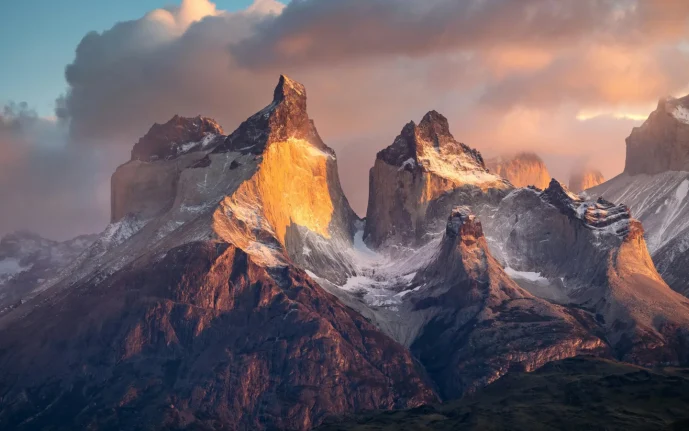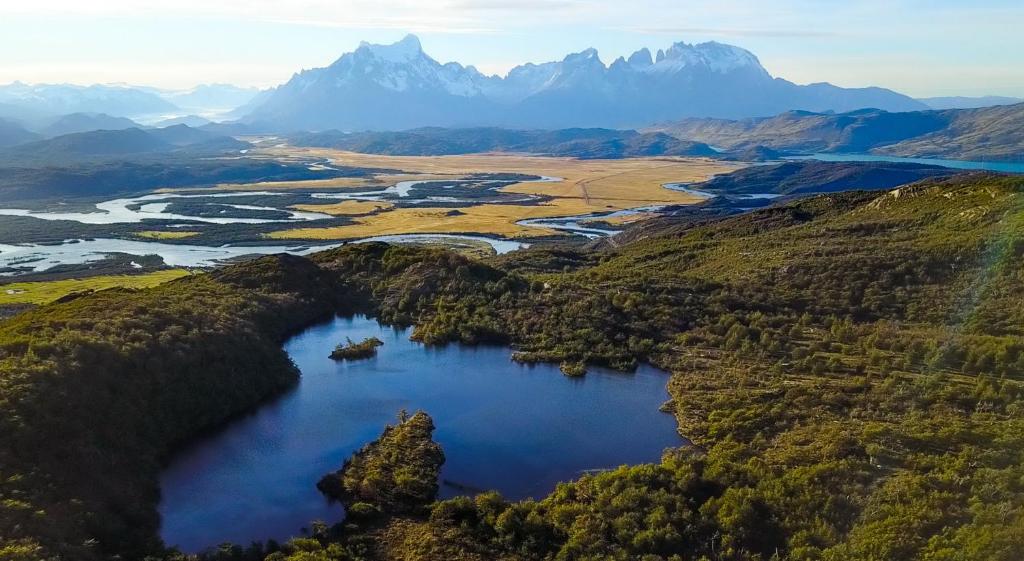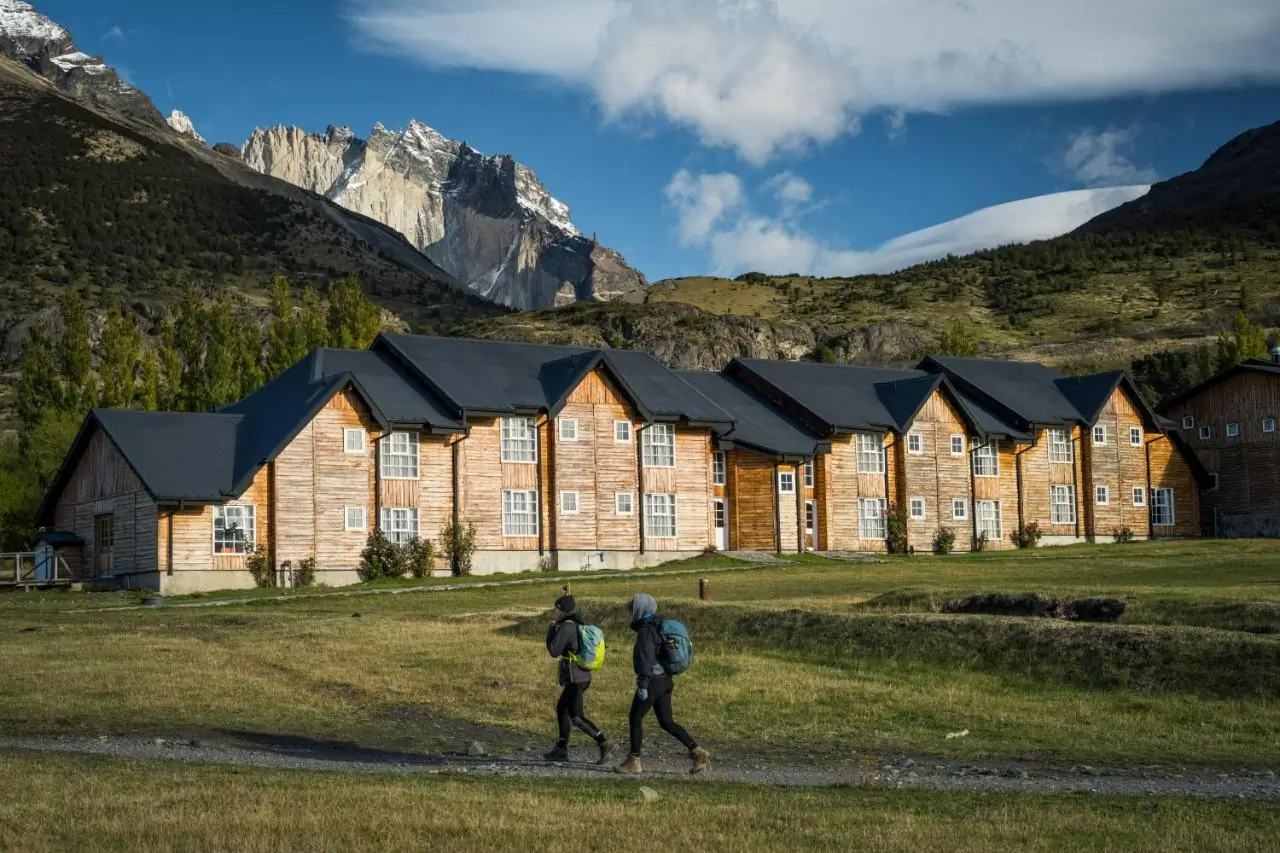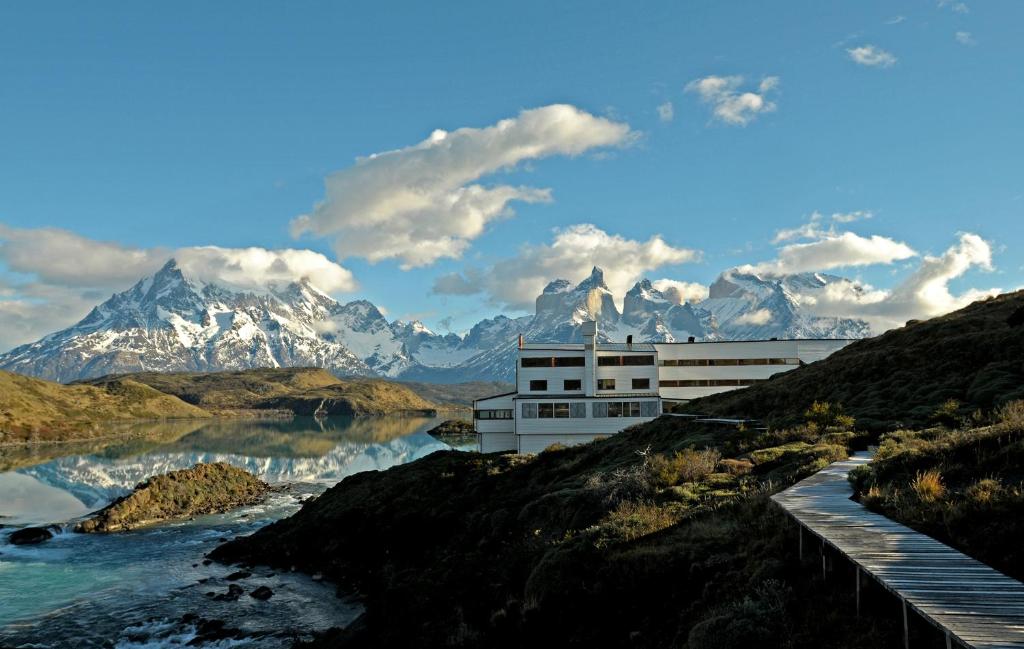Torres del Paine National Park
A breathtaking wilderness in Chile's Magallanes Region, Torres del Paine National Park dazzles with jagged granite peaks, turquoise lakes, and sprawling glaciers—a paradise for hikers and nature lovers.

In the remote wilds of Chilean Patagonia, Torres del Paine National Park is a realm of jagged granite peaks, glacial lakes, and windswept plains. Its iconic towers rise like sentinels over turquoise waters, while pumas roam the untamed steppe. A hiker’s paradise, it offers trails through ever-shifting light and landscapes—nature’s raw grandeur distilled into a single, unforgettable vista.
Destination Facts
- Official Name: Parque Nacional Torres del Paine
- Type of Destination: National Park
- Brief Description: A rugged wilderness of soaring granite peaks, glacial lakes, and vast pampas, renowned for its dramatic landscapes and exceptional trekking routes.
- Location: Southern Patagonia, within the Magallanes and Chilean Antarctica Region, near the border with Argentina.
- Year Established: 1959
- Governing Body: Corporación Nacional Forestal (CONAF)
- Significance/Known For: UNESCO Biosphere Reserve (1978), iconic granite towers (Torres del Paine), and diverse ecosystems including guanacos, pumas, and Andean condors.
- Size/Area: Approximately 181,414 hectares (448,284 acres)
- Main Attractions/Key Features:
- The three granite towers (Torres del Paine)
- Grey Glacier and Lago Grey
- Cuernos del Paine (Horns of Paine)
- Best Time to Visit: November to early March (Patagonian summer), though weather remains unpredictable year-round.
- Entrance Fee/Ticket Info: Yes, fees vary by nationality and season; check CONAF's official website for current rates.
- Operating Hours: Open year-round, but visitor centers and certain trails may have seasonal restrictions.
- Website: CONAF Torres del Paine
Essentials
- Best Months to Visit: December, February, January, November
Tours and Day Trips
Popular Tours & Day Trips from Torres del Paine National Park
1. The W Trek
One of the most iconic hikes in Patagonia, the W Trek is a 4-5 day journey through the heart of Torres del Paine, offering breathtaking views of granite peaks, glacial lakes, and emerald forests. The route connects the park’s highlights—Grey Glacier, the French Valley, and the base of the Torres themselves—making it ideal for adventurous travelers seeking immersion in raw, untamed landscapes. While challenging, it is well-marked and suitable for those with moderate hiking experience.
2. Boat Excursion to Grey Glacier
A shorter but equally mesmerizing experience, this boat trip departs from Hotel Lago Grey and navigates the icy waters of Lago Grey, bringing travelers face-to-face with the towering Grey Glacier. The three-hour excursion includes close-up views of icebergs and the glacier’s jagged blue walls, with optional kayaking for a more intimate encounter. Perfect for those who prefer to admire the park’s grandeur without strenuous trekking.
3. Full-Day Wildlife Safari
Torres del Paine is a sanctuary for Patagonian wildlife, and this guided safari focuses on spotting its elusive inhabitants. Travelers may encounter guanacos, Andean condors, and even pumas while exploring the park’s lesser-known trails. Expert guides share insights into the region’s ecology, making this a rewarding choice for nature enthusiasts and photographers. The tour typically lasts 8-10 hours, with comfortable transport and light walking.
4. Day Trip to Laguna Azul
A serene alternative to the park’s busier trails, Laguna Azul is a turquoise-hued lake framed by the iconic Torres del Paine massif. The short hike (1-2 hours) is accessible to most fitness levels, and the reflective waters offer unparalleled photo opportunities. Ideal for families or those seeking a peaceful retreat, the lagoon is a 90-minute drive from the park’s main entrances.
5. Horseback Riding in the Pampa
For a taste of Patagonian gaucho culture, this half-day excursion takes riders across the vast pampas surrounding the park. Local guides lead small groups through rolling grasslands, with the Paine massif as a dramatic backdrop. Suitable for beginners and experienced riders alike, the tour includes traditional snacks and insights into the region’s ranching heritage.
Accommodation
Camping Lago Pehoe
Nestled within the breathtaking Torres del Paine, Camping Lago Pehoe offers stunning views of turquoise waters amidst rugged Patagonian landscapes, creating an unforgettable nature retreat in Chile.
Hotel Rio Serrano
Nestled in the heart of Torres del Paine National Park, Hotel Rio Serrano offers breathtaking views of the Patagonian wilderness, luxurious accommodations, and easy access to outdoor adventures.

Hostería Lago del Toro
Nestled in the heart of Torres del Paine National Park, Hostería Lago del Toro offers stunning views of the Paine Massif and serene access to Patagonia's pristine wilderness.
Hosteria Lago Tyndall
Nestled in the heart of Parque Nacional Torres del Paine, Hosteria Lago Tyndall offers cozy accommodations with stunning views of Patagonia's rugged landscapes and pristine lakes.
Camping Río Serrano – Caja Los Andes
Nestled in the heart of Torres del Paine National Park, Camping Río Serrano offers stunning views of the Paine Massif and easy access to hiking trails, perfect for nature enthusiasts.
Lodge Morrena Torres del Paine
Nestled in the heart of Torres del Paine National Park, Lodge Morrena offers breathtaking views of the iconic granite towers, providing a serene retreat for nature lovers and adventurers alike.
Kau Río Serrano
Nestled in the heart of Chile's Torres del Paine National Park, Kau Río Serrano offers breathtaking views of rugged mountains, pristine rivers, and unparalleled access to Patagonia's natural wonders.
Hostería Lago del Toro
Nestled in the heart of Torres del Paine National Park, Hostería Lago del Toro offers stunning views of the Paine Massif and serene access to Patagonia's pristine wilderness.
Konkashken Lodge
Nestled in the heart of Torres del Paine National Park, Konkashken Lodge offers a serene retreat surrounded by breathtaking Patagonian landscapes, perfect for nature lovers and adventurers.
Hotel del Paine
Nestled in the heart of Torres del Paine National Park, Hotel del Paine offers luxurious accommodations with breathtaking views of Patagonia's rugged mountains, glaciers, and pristine lakes.
Refugio Vista al Paine
Refugio Vista al Paine, nestled in Chile's Torres del Paine National Park, offers breathtaking views of rugged peaks, glaciers, and serene landscapes, perfect for nature lovers and adventurers.
Konkashken Lodge
Nestled in the heart of Torres del Paine National Park, Konkashken Lodge offers a serene retreat surrounded by breathtaking Patagonian landscapes, perfect for nature lovers and adventurers.
Refugio Los Cuernos
Nestled in the heart of Torres del Paine National Park, Refugio Los Cuernos offers stunning views of the iconic Cuernos del Paine peaks, providing a cozy retreat for hikers exploring Chile's Patagonian wilderness.
Camping Italiano
Camping Italiano, nestled in the heart of Torres del Paine National Park, offers breathtaking views of rugged peaks and pristine wilderness, perfect for hikers and nature enthusiasts.
Camping Paine Grande
Camping Paine Grande, nestled in the heart of Torres del Paine National Park, offers breathtaking views of the Paine Massif and is a perfect base for exploring Chile's iconic Patagonian landscapes.
Sheuen Patagonia
Sheuen Patagonia in Puerto Natales offers an enchanting retreat with breathtaking views of the Patagonian landscape, providing guests with warm hospitality and authentic Chilean cuisine.
Hotel Las Torres

Hotel Lago Grey
Hotel Explora Torres del Paine
A luxurious retreat in Chile's Torres del Paine, Hotel Explora offers breathtaking views of rugged peaks, turquoise lakes, and endless trails—perfect for adventurers seeking comfort amid Patagonia's wild beauty.

Hotel Tierra Patagonia
A luxurious retreat nestled on the shores of Lake Sarmiento, Hotel Tierra Patagonia offers breathtaking views of Torres del Paine National Park, blending eco-conscious design with unparalleled access to Patagonia’s wild beauty.
Hosteria Pehoe
A stunning lakeside retreat in Torres del Paine National Park, Hosteria Pehoe offers breathtaking views of the Paine Massif and easy access to iconic trails, blending rustic charm with unforgettable Patagonian scenery.

When to visit
Best Time to Visit Torres del Paine National Park
Torres del Paine, a jewel of Patagonia, offers dramatically different experiences depending on the season. Its remote location in far southern Chile means weather is unpredictable, but each season brings its own allure—whether for trekking, wildlife spotting, or solitude.
Seasonal Breakdown
Summer (December–February)
Weather: The warmest months, with temperatures ranging from 5°C to 18°C (41°F–64°F). Days are long (up to 17 hours of daylight), but winds can be fierce, and rain is frequent.
- Pros: Ideal for hiking the W Trek or O Circuit; wildlife (guanacos, condors) is active; refugios and services are fully operational.
- Cons: Crowds peak in January; reservations for campsites and lodges must be made months in advance.
Events: New Year’s celebrations in Puerto Natales (gateway town) draw visitors, but the park itself remains quiet.
Autumn (March–April)
Weather: Cooler (3°C–12°C / 37°F–54°F) but more stable, with fewer rain showers. Autumn colors paint the landscapes in gold and red.
- Pros: Fewer crowds; photographers favor the soft light and vibrant foliage; pumas are more visible.
- Cons: Some refugios close by late April; shorter daylight hours.
Winter (May–September)
Weather: Harsh and cold (-2°C to 5°C / 28°F–41°F), with snow covering the peaks. Winds are less intense, but trails may be icy or closed.
- Pros: Stark, snow-draped beauty for intrepid travelers; solitude is guaranteed; winter wildlife like foxes and hares emerge.
- Cons: Most trails and refugios are closed; access is limited to short day hikes from hotels.
Events: Fiesta de la Nieve (Snow Festival) in Punta Arenas in July, though distant, adds regional charm.
Spring (October–November)
Weather: Unpredictable—sudden snowstorms alternate with sunny days (0°C–10°C / 32°F–50°F). Flowers begin to bloom by November.
- Pros: Quiet before the summer rush; newborn guanacos and lambs dot the valleys.
- Cons: Trails may still be muddy or snow-covered; services reopen gradually.
Overall Recommendation
For trekkers, January–February offers the most reliable conditions, though March–April is preferable for those seeking tranquility. Photographers should target autumn’s golden hues (March–April) or winter’s stark beauty (June–July). Winter travelers must embrace solitude and limited access.
Considerations
Peak season (December–February) demands advance bookings and higher prices. Shoulder seasons (March–April, October–November) balance accessibility and affordability. Winter visits require self-sufficiency but reward with rare serenity.
What to pack
What to Pack for Torres del Paine National Park
Weather-Resistant Gear
The Patagonian climate is notoriously unpredictable, with strong winds, sudden rain, and rapid temperature shifts. Packing for all conditions is essential.
- Layered Clothing: Merino wool or synthetic base layers, a fleece or insulated mid-layer, and a waterproof outer shell to adapt to changing conditions.
- Sturdy Hiking Boots: Waterproof, ankle-supporting boots for uneven terrain and river crossings.
- Windproof Gloves & Hat: Essential for early mornings and high-altitude hikes where wind chill is severe.
Hiking Essentials
The park’s rugged trails demand practical preparation, especially for multi-day treks.
- Trekking Poles: Helpful for stability on steep ascents and descents, particularly in muddy or rocky sections.
- Lightweight Daypack: A 20-30L pack with a rain cover for daily excursions.
- Water Purification Tablets or Filter: Streams and rivers are plentiful, but untreated water is unsafe to drink.
Protection from the Elements
The sun and wind are deceptively harsh, even on cloudy days.
- High-SPF Sunscreen & Lip Balm: The ozone layer is thin here, and UV exposure is intense.
- Polarized Sunglasses: Glare from lakes and glaciers can be blinding; wrap-around styles shield against wind.
- Buff or Neck Gaiter: Versatile for face protection against dust, wind, or cold.
Camping & Overnight Considerations
For those staying in refugios or camping, a few extras ensure comfort.
- Earplugs & Sleep Mask: Refugios are communal, and summer daylight lasts nearly 18 hours.
- Quick-Dry Towel: Compact and practical for shared facilities.
- Cash (Chilean Pesos): Some remote refugios or transport services don’t accept cards.
Culture
The Gaucho Legacy
Torres del Paine National Park is deeply intertwined with the traditions of the Patagonian gaucho, a rugged horseman whose way of life has shaped the region’s cultural identity. Unlike the more commercialized estancias elsewhere in Argentina or Chile, the gauchos here maintain a quieter, more solitary existence, often working in remote corners of the park. Their skills in sheep herding and horsemanship are not performances for tourists but a living tradition. Visitors may encounter them guiding cattle or sharing stories over a mate tea—a ritual as much about camaraderie as it is about warmth.
Indigenous Roots & Conservation Ethos
Though the park itself is a protected area, the surrounding lands bear the imprint of the Aónikenk (Tehuelche) people, who once traversed these steppes. While their presence is less visible today, their legacy persists in place names and the reverence for the land’s raw beauty. The park’s conservation efforts, led by local rangers and scientists, reflect a modern extension of this ethos—balancing tourism with preservation. Engaging with park guides, many of whom are Magallanes natives, offers insights into this delicate equilibrium.
Culinary Simplicity
Patagonian cuisine here is stripped to its essentials, a reflection of the harsh climate and isolation. Lamb roasted over an open fire (asado al palo) is the centerpiece, often prepared at rustic lodges or estancias bordering the park. The flavors are unadorned, relying on the quality of locally raised meat and the slow, smoky cooking process. Foraged ingredients like calafate berries appear in jams or desserts, their tartness a counterpoint to rich meats—a taste of the land itself.
Silence as a Cultural Marker
Unlike many tourist destinations, Torres del Paine’s cultural texture is woven with silence. The vastness of the landscape imposes a quietude that locals respect instinctively. Conversations in refugios or on trails are often hushed, not out of reticence but to honor the wind, the distant rumble of glaciers, or the call of a condor. This unspoken etiquette is perhaps the park’s most profound cultural lesson.
Practical Notes for Visitors
- When offered mate, accept it—it’s a gesture of trust. Pass it back without stirring the straw (bombilla).
- Gaucho demonstrations are rare; respect their work as part of daily life, not a spectacle.
- Ask before photographing people, especially in remote areas like Cerro Castillo.
History
A Land Shaped by Ice and Time
Torres del Paine National Park, a jewel of Patagonia, is a landscape sculpted by millennia of glacial activity and volcanic forces. Its iconic granite spires—the Torres del Paine—rise dramatically against the sky, a testament to the Earth’s geological artistry. Long before European explorers arrived, the region was inhabited by the Aónikenk (Tehuelche) people, nomadic hunters who traversed these windswept plains. The park’s modern history is one of exploration, conservation, and reverence for its untamed beauty.
Key Historical Dates
- 1879: British explorer Lady Florence Dixie becomes one of the first Europeans to document the area, dubbing the towers “Cleopatra’s Needles” in her travel writings.
- 1959: The Chilean government establishes Torres del Paine National Park, initially spanning 4,330 square kilometers, to protect its unique ecosystems and dramatic landscapes.
- 1978: UNESCO designates the park as a Biosphere Reserve, recognizing its ecological significance and fragile biodiversity.
- 2011: A devastating wildfire, sparked by a tourist’s negligence, burns over 17,000 hectares, prompting stricter conservation measures and renewed awareness of the park’s vulnerability.
Human Footprints in the Wilderness
The Aónikenk left little physical trace of their presence, but their oral traditions speak of the park’s mountains as sacred. In the late 19th century, European settlers arrived, establishing estancias for sheep farming, remnants of which can still be seen today. The park’s transformation into a protected area marked a shift from exploitation to preservation, though the balance between tourism and conservation remains delicate.